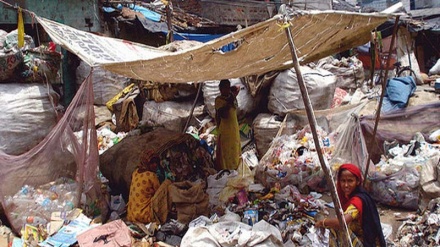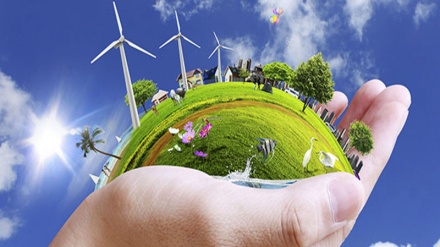We Only Have One Planet to Live On (12)
Welcome to the 12th weekly episode of the series We Only Have One Planet to Live On. Today, we speak of marine oil spills.
One of the widespread and most dangerous pollutions and contaminations which currently threaten seas and oceans are the oil spills. The issue of marine oil spills was mentioned for the very first time in the year 1967, when an oil tanker had an accident next to southern coastlines of England. In this accident, 100,000 tons of crude oil was released into sea. The British Air Force bombarded this oil tanker with military planes in order to prevent the spread of pollution so that the remaining oil spills would be burnt and wiped out. In this manner, this incident drew the attention of world countries toward this potential threat. This is because oil spills do not just threaten seas, aquatics, and ship crews, and the catastrophe in fact runs deeper. The fact of the matter is that the scattered oil spills evaporate as the result of sunrays and thereafter return to Earth in the form of rainfalls and mist, endangering agricultural products, mankind, and other live creatures.
Based on announced figures, every year roughly 14,000 cases of oil spills occur across seas and oceans; most of which are minor incidents and are contained. However, some of these oil spills bring about catastrophic consequences. In the year 1989, 42 million liters of crude oil leaked from an oil tanker at Prince William Strait in Alaska. Another oil tanker released 98 million liters of crude oil into sea in Scotland in the year 1993. Although ships highly contribute to contamination of seas; the major sources of contamination are oil wells, rigs, and platforms. The leakage of oil in the Gulf of Mexico is one of the main environmental catastrophes which took place on April 20, 2010. The explosion of British Petroleum’s Deep Water Horizon Oil Platform left eleven personnel dead and released more than 4 million barrels of oil in the Gulf of Mexico, which is marked as the largest unintentional leakage of oil in the course of history. This oil spill covered an area of more than 300 square kilometers and endangered many regional animals, destroying their habitats. A few weeks after this leakage, fishermen netted wounded fish in this region. In accordance to the studies which have been carried out, these open wounds are sign of infections that have threatened the life of aquatics even several years after the oil leakage in the Gulf of Mexico. Coral reefs, algae, dolphins, and other flora and fauna species have been harmed due to oil leakage.
One of the other regions which have always been exposed to oil contamination is the Persian Gulf region in southern Iran. Persian Gulf waters are home to 25 major oil terminals. Every year, 20,000 to 30,000 oil tankers pass through the Strait of Hormuz. The leakage of tens of thousands of tons of oil as the result of movement of these oil tankers has turned these waters into one of the most polluted marine environments.
The Deputy Head of Islamic Republic of Iran Environment Protection Organization, Abdul-Reza Karbasi, in a recent interview, pointed out that the volume of oil leaked due to transportation of ships as of the year 2000 to 2009 AD has been roughly 114000 tons per annum. From 2009-2015, nearly 93000 tons of oil has been leaked every year.
Certainly, oil spills throughout seas and oceans leave destructive impacts on the related ecosystem, in general. This is because oil layers prevent the exchange of oxygen and air and lead to death of aquatics and their sources of existence. On the other hand, these contaminations lower the penetration of sunrays to the depths of oceans, and undermine the photosynthesis process of plants. The entry of oil drops into the body of marine creatures at times leads to their death. Small fish, snails, sea shells, marine sponges, jellyfish, turtles, dolphins and sharks are some of marine creatures which are vulnerable to oil drops.
Meanwhile, many of the wastes which have entered oceans do not disintegrate and remain inside waters for years, consuming oxygen, thereby lowering the volume of oxygen in water and reducing the chance of survival of whales, turtles, sharks, dolphins and penguins. On the other hand, the marine creatures which consume pollutants in oceans are placed within the human food chain. Such materials disintegrate in human bodies, causing cancer, birth defects, and/or long term ailments.
Water birds are also harmed as the result of oil spills. The feathers of these birds are contaminated with oil spills, taking away their ability to fly. Moreover, due to these contaminations, these feathers no longer act as insulators, exposing the water birds to death. More than 6,000 birds died in the oil leakage in the Gulf of Mexico. The oil leaks also threaten the lives of plants across the coastlines. Incoming reports refer to destruction of algae and other coastal plants.
Mounting environmental impacts as the result of oil leakage at seas have motivated the international community to take strides for removal of the existing problems. One of the most important treaties in regard to oil spills was approved by governments in the year 1969 AD. Meanwhile, in this phase in time, the international community realized that only conclusion of global and regional treaties on oil spills, in the absence of any practical measure by governments, is a pointless act.
MR/SS


